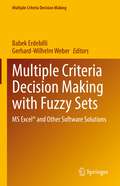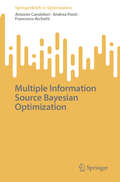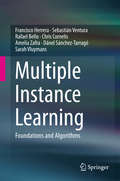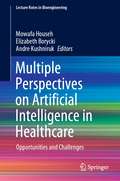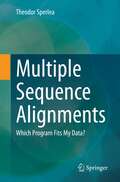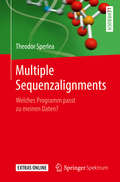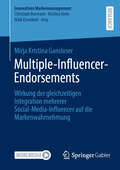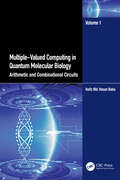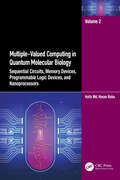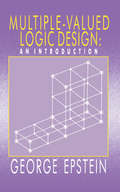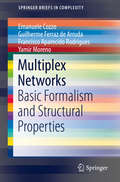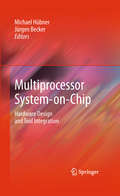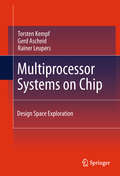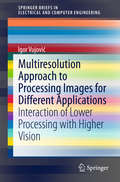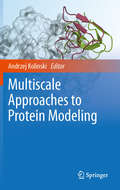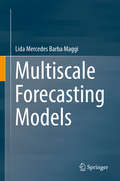- Table View
- List View
Multiple Criteria Decision Aid: Methods, Examples and Python Implementations (Springer Optimization and Its Applications #136)
by Jason Papathanasiou Nikolaos PloskasMultiple criteria decision aid (MCDA) methods are illustrated in this book through theoretical and computational techniques utilizing Python. Existing methods are presented in detail with a step by step learning approach. Theoretical background is given for TOPSIS, VIKOR, PROMETHEE, SIR, AHP, goal programming, and their variations. Comprehensive numerical examples are also discussed for each method in conjunction with easy to follow Python code. Extensions to multiple criteria decision making algorithms such as fuzzy number theory and group decision making are introduced and implemented through Python as well. Readers will learn how to implement and use each method based on the problem, the available data, the stakeholders involved, and the various requirements needed. Focusing on the practical aspects of the multiple criteria decision making methodologies, this book is designed for researchers, practitioners and advanced graduate students in the applied mathematics, information systems, operations research and business administration disciplines, as well as other engineers and scientists oriented in interdisciplinary research. Readers will greatly benefit from this book by learning and applying various MCDM/A methods. (Adiel Teixeira de Almeida, CDSID-Center for Decision System and Information Development, Universidade Federal de Pernambuco, Recife, Brazil) Promoting the development and application of multicriteria decision aid is essential to ensure more ethical and sustainable decisions. This book is a great contribution to this objective. It is a perfect blend of theory and practice, providing potential users and researchers with the theoretical bases of some of the best-known methods as well as with the computing tools needed to practice, to compare and to put these methods to use. (Jean-Pierre Brans, Vrije Universiteit Brussel, Brussels, Belgium) This book is intended for researchers, practitioners and students alike in decision support who wish to familiarize themselves quickly and efficiently with multicriteria decision aiding algorithms. The proposed approach is original, as it presents a selection of methods from the theory to the practical implementation in Python, including a detailed example. This will certainly facilitate the learning of these techniques, and contribute to their effective dissemination in applications. (Patrick Meyer, IMT Atlantique, Lab-STICC, Univ. Bretagne Loire, Brest, France)
Multiple Criteria Decision Making and Aiding: Cases on Models and Methods with Computer Implementations (International Series in Operations Research & Management Science #274)
by Adiel Teixeira de Almeida Martin Josef Geiger Sandra HuberThis book introduces students on Multiple Criteria Decision Aiding and Making courses to practical, real-world cases. Each case study introduces a problem or situation together with a method, and a description and explanation of a computer application. In this sense each chapter is based on four pillars: the problem, the model building, the methods and their implementation. The book presents and elaborates a rich and comprehensive set of practical problems comprising multiple criteria, including numerous approaches for their solution, for decision support or decision aid. It complements traditional textbooks and lecture material by employing case studies to promote a deeper understanding of the investigated concepts and help students apply these methods to other areas.
Multiple Criteria Decision Making with Fuzzy Sets: MS Excel® and Other Software Solutions (Multiple Criteria Decision Making)
by Gerhard-Wilhelm Weber Babek ErdebilliUsing numerical examples to illustrate their concepts and results, this book examines recently developed fuzzy multi-criteria methods, such as Intuitionistic Fuzzy TOPSIS, Intuitionistic Fuzzy TOPSIS & DEA-AHP, Intuitionistic VIKOR, Pythagorean WASPAS, Pythagorean ENTROPI, Hesitant CBD, Hesitant MABAC, Triangular EDAS, Triangular PROMETHEE, q-Rung Orthopair COPRAS, and Fuzzy Type – 2 ELECTRE. Each chapter covers practical applications in addition to fresh developments and results. Given its structure and scope, the book can be used as a textbook in graduate courses on operations research and industrial engineering. It also offers a valuable resource for scientists working in a range of disciplines that require multi-criteria decision making.
Multiple Information Source Bayesian Optimization (SpringerBriefs in Optimization)
by Francesco Archetti Antonio Candelieri Andrea PontiThe book provides a comprehensive review of multiple information sources and multi-fidelity Bayesian optimization, specifically focusing on the novel "Augmented Gaussian Process” methodology. The book is important to clarify the relations and the important differences in using multi-fidelity or multiple information source approaches for solving real-world problems. Choosing the most appropriate strategy, depending on the specific problem features, ensures the success of the final solution. The book also offers an overview of available software tools: in particular it presents two implementations of the Augmented Gaussian Process-based Multiple Information Source Bayesian Optimization, one in Python -- and available as a development branch in BoTorch -- and finally, a comparative analysis against other available multi-fidelity and multiple information sources optimization tools is presented, considering both test problems and real-world applications. The book will be useful to two main audiences: 1. PhD candidates in Computer Science, Artificial Intelligence, Machine Learning, and Optimization 2. Researchers from academia and industry who want to implement effective and efficient procedures for designing experiments and optimizing computationally expensive experiments in domains like engineering design, material science, and biotechnology.
Multiple Instance Learning
by Sebastián Ventura Francisco Herrera Rafael Bello Chris Cornelis Amelia Zafra Dánel Sánchez-Tarragó Sarah VluymansThis book provides a general overview of multiple instance learning (MIL), defining the framework and covering the central paradigms. The authors discuss the most important algorithms for MIL such as classification, regression and clustering. With a focus on classification, a taxonomy is set and the most relevant proposals are specified. Efficient algorithms are developed to discover relevant information when working with uncertainty. Key representative applications are included. This book carries out a study of the key related fields of distance metrics and alternative hypothesis. Chapters examine new and developing aspects of MIL such as data reduction for multi-instance problems and imbalanced MIL data. Class imbalance for multi-instance problems is defined at the bag level, a type of representation that utilizes ambiguity due to the fact that bag labels are available, but the labels of the individual instances are not defined. Additionally, multiple instance multiple label learning is explored. This learning framework introduces flexibility and ambiguity in the object representation providing a natural formulation for representing complicated objects. Thus, an object is represented by a bag of instances and is allowed to have associated multiple class labels simultaneously. This book is suitable for developers and engineers working to apply MIL techniques to solve a variety of real-world problems. It is also useful for researchers or students seeking a thorough overview of MIL literature, methods, and tools.
Multiple Perspectives on Artificial Intelligence in Healthcare: Opportunities and Challenges (Lecture Notes in Bioengineering)
by Mowafa Househ Elizabeth Borycki Andre KushnirukThis book offers a comprehensive yet concise overview of the challenges and opportunities presented by the use of artificial intelligence in healthcare. It does so by approaching the topic from multiple perspectives, e.g. the nursing, consumer, medical practitioner, healthcare manager, and data analyst perspective. It covers human factors research, discusses patient safety issues, and addresses ethical challenges, as well as important policy issues. By reporting on cutting-edge research and hands-on experience, the book offers an insightful reference guide for health information technology professionals, healthcare managers, healthcare practitioners, and patients alike, aiding them in their decision-making processes. It will also benefit students and researchers whose work involves artificial intelligence-related research issues in healthcare.
Multiple Perspectives on Problem Solving and Learning in the Digital Age
by Dirk Ifenthaler J. Michael Spector Kinshuk Pedro Isaias Demetrios G. SampsonThis edited volume with selected expanded papers from CELDA (Cognition and Exploratory Learning in the Digital Age) 2009 (http://www.celda-conf.org/) addresses the main issues concerned with problem solving, evolving learning processes, innovative pedagogies, and technology-based educational applications in the digital age. There have been advances in both cognitive psychology and computing that have affected the educational arena. The convergence of these two disciplines is increasing at a fast pace and affecting academia and professional practice in many ways. Paradigms such as just-in-time learning, constructivism, student-centered learning and collaborative approaches have emerged and are being supported by technological advancements such as simulations, virtual reality and multi-agents systems. These developments have created both opportunities and areas of serious concerns. This volume aims to cover both technological as well as pedagogical issues related to these developments.
Multiple Sensing-Driven Feature Extraction and Defect Detection
by Guangrui Wen Zhifen Zhang Wenjing RenThis book reports the recent study results in applying online signals and artificial intelligence for welding and laser additive manufacturing (AM). It provides insights on the fundament of quality monitoring and intelligent defect detections for welding and laser AM using arc sound and plasma spectral signals collected during the manufacturing processes. Analyzing respectively from a global and local perspective establishes a knowledge base of features characterizing welding statuses. Researchers, scientists, and engineers in intelligent welding and laser AM can benefit from the book. As such, this book provides valuable knowledge, valuable methods, and practical algorithms that can be considered in real-time defect detection for welding and laser AM.
Multiple Sequence Alignments: Which Program Fits My Data?
by Theodor SperleaThis book is a practical guide for biologists who use multiple sequence alignments (MSAs) for their data analysis and are looking for a comprehensive overview of the many different programs. Despite their important role in data analysis, there is uncertainty among researchers about exactly how MSA programs work - not to mention how and why the different analyzes lead to different results. Which program is the right one for evaluating my data and how can I ensure that I have drawn all relevant findings from the alignments? This book offers helpful explanations and background information without requiring extensive bioinformatics knowledge and slowly introduces the reader to the topic.In the first part of the book, the possible fields of application as well as the formats that are usually produced by MSA programs are described in detail. The central algorithms as well as the internal processes of the most common MSA programs of the past and the present are also explained in an uncomplicated manner in greater detail. The second part of the book is a detailed, data-based comparison between MSA programs, which is intended to help you decide which program to use for your next alignment.
Multiple Sequenzalignments: Welches Programm passt zu meinen Daten?
by Theodor SperleaDieses Buch ist ein praktischer Ratgeber für Biologinnen und Biologen, die Multiple Sequenzalignments (MSAs) für ihre Datenanalysen verwenden und einen verständlichen Überblick über die vielen verschiedenen Programme suchen. Trotz ihres wichtigen Stellenwertes in der Datenanalyse herrscht Unsicherheit unter den Forschenden wie MSA-Programme genau funktionieren - ganz zu schweigen davon, wie und warum die unterschiedlichen Analysen zu verschiedenen Ergebnissen führen. Welches Programm ist für die Auswertung meiner Daten das richtige und wie kann ich sicherstellen, alle relevanten Erkenntnisse aus den Alignments gezogen zu haben? Dieses Buch bietet hilfreiche Erklärungen und Hintergründe ohne große bioinformatische Vorkenntnisse vorauszusetzen und führt die Leserinnen und Leser langsam in die Thematik ein.Im ersten Teil des Buches werden die möglichen Einsatzfelder wie auch die Formate, die üblicherweise von MSA-Programmen produziert werden, im Detail beschrieben. Ebenso werden auf unkomplizierte Weise die zentralen Algorithmen sowie die inneren Abläufe der gängigsten MSA-Programme der Vergangenheit und der Gegenwart in größerer Detailtiefe erklärt. Den zweiten Teil des Buches bildet ein ausführlicher datenbasierter Vergleich zwischen MSA-Programmen, der als Entscheidungshilfe für die Programmauswahl für dein nächstes Alignment dienen soll.
Multiple-Aspect Analysis of Semantic Trajectories: First International Workshop, MASTER 2019, Held in Conjunction with ECML-PKDD 2019, Würzburg, Germany, September 16, 2019, Proceedings (Lecture Notes in Computer Science #11889)
by Chiara Renso Stan Matwin Konstantinos TserpesThis open access book constitutes the refereed post-conference proceedings of the First International Workshop on Multiple-Aspect Analysis of Semantic Trajectories, MASTER 2019, held in conjunction with the 19th European Conference on Machine Learning and Knowledge Discovery in Databases, ECML PKDD 2019, in Würzburg, Germany, in September 2019.The 8 full papers presented were carefully reviewed and selected from 12 submissions. They represent an interesting mix of techniques to solve recurrent as well as new problems in the semantic trajectory domain, such as data representation models, data management systems, machine learning approaches for anomaly detection, and common pathways identification.
Multiple-Base Number System: Theory and Applications (Circuits and Electrical Engineering)
by Vassil Dimitrov Graham Jullien Roberto MuscedereComputer arithmetic has become so fundamentally embedded into digital design that many engineers are unaware of the many research advances in the area. As a result, they are losing out on emerging opportunities to optimize its use in targeted applications and technologies. In many cases, easily available standard arithmetic hardware might not necessarily be the most efficient implementation strategy. Multiple-Base Number System: Theory and Applications stands apart from the usual books on computer arithmetic with its concentration on the uses and the mathematical operations associated with the recently introduced multiple-base number system (MBNS). The book identifies and explores several diverse and never-before-considered MBNS applications (and their implementation issues) to enhance computation efficiency, specifically in digital signal processing (DSP) and public key cryptography. Despite the recent development and increasing popularity of MBNS as a specialized tool for high-performance calculations in electronic hardware and other fields, no single text has compiled all the crucial, cutting-edge information engineers need to optimize its use. The authors’ main goal was to disseminate the results of extensive design research—including much of their own—to help the widest possible audience of engineers, computer scientists, and mathematicians. Dedicated to helping readers apply discoveries in advanced integrated circuit technologies, this single reference is packed with a wealth of vital content previously scattered throughout limited-circulation technical and mathematical journals and papers—resources generally accessible only to researchers and designers working in highly specialized fields. Leveling the informational playing field, this resource guides readers through an in-depth analysis of theory, architectural techniques, and the latest research on the subject, subsequently laying the groundwork users require to begin applying MBNS.
Multiple-Choice and Free-Response Questions in Preparation for the AP Computer Science Examination
by Leon SchramThe review concludes with a set of tricky questions, also known as snooker questions. A snooker question is a question that a student with good knowledge of a topic, nevertheless gets wrong. Therefore, we have devoted a large chapter for snooker questions. This new chapter covers 15 major topic areas that are tested on the AP Exam and provides two questions for each topic, to assist students with subtle trickiness in questions.
Multiple-Influencer-Endorsements: Wirkung der gleichzeitigen Integration mehrerer Social-Media-Influencer auf die Markenwahrnehmung (Innovatives Markenmanagement)
by Mirja Kristina GansloserVerändertes Mediennutzungsverhalten führt dazu, dass soziale Medien und Social-Media-Influencer (SMIs) eine zentrale Rolle in der Markenkommunikation einnehmen. Immer mehr Unternehmen kooperieren gleichzeitig mit mehreren SMIs unterschiedlicher Followerzahl, um die Markenwahrnehmung gezielt zu beeinflussen. Eine qualitative Vorstudie zeigt, dass die Integration mehrerer SMIs die Markenwahrnehmung sowohl positiv als auch negativ beeinflussen kann. Die Wirkung von Multiple-Influencer-Endorsements auf markenbezogene Zielgrößen wurde in der bestehenden Literatur bislang nicht erforscht. Mirja Kristina Gansloser widmet sich dieser Forschungslücke und untersucht empirisch, wie gleichzeitige Markenbewerbungen durch verschiedene SMIs das Globalimage, die Follow Intention und die Kaufintention beeinflussen. Aus den Erkenntnissen leitet sie praxisorientierte Handlungsempfehlungen für das strategische Management von Influencer-Kooperationen ab, mit Fokus auf zielgerichtete und authentische Content-Gestaltung.
Multiple-Valued Computing in Quantum Molecular Biology: Arithmetic and Combinational Circuits
by Hafiz Md. BabuThis book focuses on the design methodologies of various quantum circuits, DNA circuits, DNA-quantum circuits and quantum-DNA circuits. It considers the merits and challenges of multivalued logic circuits in quantum, DNA, quantum-DNA and DNA-quantum computing. Multiple-Valued Computing in Quantum Molecular Biology: Arithmetic and Combinational Circuits is Volume 1 of a two-volume set. From fundamentals to advanced levels, this book discusses different multiple-valued logic DNA-quantum and quantum-DNA circuits. The text consists of four parts. Part I introduces multiple-valued quantum computing and DNA computing. It contains the basic understanding of multiple-valued quantum computing, multiple-valued DNA computing, multiple-valued quantum-DNA computing and multiple-valued DNA-quantum computing. Part II examines heat calculation, speed calculation, heat transfer, data conversion and data management in multi-valued quantum, DNA, quantum-DNA and DNA-quantum computing. Part III discusses multiple-valued logic operations in quantum and DNA computing such as ternary AND, NAND, OR, NOR, XOR, XNOR and multiple-valued arithmetic operations such as adder, multiplier, divider and more. Quantum-DNA and DNA-quantum multiple-valued arithmetic operations are also explained in this section. Part IV explains multiple-valued quantum and DNA combinational circuits such as multiple-valued DNA-quantum and quantum-DNA multiplexer, demultiplexer, encoder and decoder. This book will be of great help to researchers and students in quantum computing, DNA computing, quantum-DNA computing and DNA-quantum computing researchers.
Multiple-Valued Computing in Quantum Molecular Biology: Sequential Circuits, Memory Devices, Programmable Logic Devices, and Nanoprocessors
by Hafiz Md. BabuThis book mainly focuses on the design methodologies of various quantum circuits, DNA circuits, DNA-quantum circuits, and quantum-DNA circuits. In this text, the author has compiled various design aspects of multiple-valued logic DNA-quantum and quantum-DNA sequential circuits, memory devices, programmable logic devices, and nanoprocessors. Multiple-Valued Computing in Quantum Molecular Biology: Sequential Circuits, Memory Devices, Programmable Logic Devices, and Nanoprocessors is Volume 2 of a two-volume set, and consists of four parts. This book presents various design aspects of multiple-valued logic DNA-quantum and quantum-DNA sequential circuits, memory devices, programmable logic devices, and nanoprocessors. Part I discusses multiple-valued quantum and DNA sequential circuits such as D flip-flop, SR latch, SR flip-flop, JK flip-flop, T flip-flop, shift register, ripple counter, and synchronous counter, which are described, respectively, with the applications and working procedures. After that, multiple-valued quantum-DNA and DNA-quantum sequential circuits such as D flip-flop, SR flip-flop, JK flip-flop, T flip-flop, shift register, ripple counter and synchronous counter circuits are explained with working procedures and architecture. Part II discusses the architecture and design procedure of memory devices such as random access memory (RAM), read-only memory (ROM), programmable read-only memory (PROM), and cache memory, which are sequentially described in multiple-valued quantum, DNA, quantum-DNA, and DNA-quantum computing. In Part III, the author examines the architectures and working principles of programmable logic devices such as programmable logic array (PLA), programmable array logic (PAL), field programmable gate array (FPGA), and complex programmable logic device (CPLD) in multiple-valued quantum, DNA, quantum-DNA, and DNA-quantum computing. Multiple-valued quantum, DNA, quantum-DNA, and DNA-quantum nanoprocessors are designed with algorithms in Part IV. Furthermore, the basic components of ternary nanoprocessors such as T-RAM, ternary instruction register, ternary incrementor circuit, ternary decoder, ternary multiplexer, ternary accumulator in quantum, DNA, quantum-DNA, and DNA-quantum computing are also explained in detail. This book will be of great help to researchers and students in quantum computing, DNA computing, quantum-DNA computing, and DNA-quantum computing.
Multiple-Valued Logic Design: an Introduction
by G EpsteinMultiple-Valued Logic Design: An Introduction explains the theory and applications of this increasingly important subject. Written in a clear and understandable style, the author develops the material in a skillful way. Without using a huge mathematical apparatus, he introduces the subject in a general form that includes the well-known binary logic as a special case. The book is further enhanced by more 200 explanatory diagrams and circuits, hardware and software applications with supporting PASCAL programming, and comprehensive exercises with even-numbered answers for every chapter. Requiring introductory knowledge in Boolean algebra, 2-valued logic, or 2-valued switching theory, Multiple-Valued Logic Design: An Introduction is an ideal book for courses not only in logic design, but also in switching theory, nonclassical logic, and computer arithmetic. Computer scientists, mathematicians, and electronic engineers can also use the book as a basis for research into multiple-valued logic design.
Multiplex Networks: Basic Formalism and Structural Properties (SpringerBriefs in Complexity)
by Emanuele Cozzo Guilherme Ferraz de Arruda Francisco Aparecido Rodrigues Yamir MorenoThis book provides the basis of a formal language and explores its possibilities in the characterization of multiplex networks. Armed with the formalism developed, the authors define structural metrics for multiplex networks. A methodology to generalize monoplex structural metrics to multiplex networks is also presented so that the reader will be able to generalize other metrics of interest in a systematic way. Therefore, this book will serve as a guide for the theoretical development of new multiplex metrics. Furthermore, this Brief describes the spectral properties of these networks in relation to concepts from algebraic graph theory and the theory of matrix polynomials. The text is rounded off by analyzing the different structural transitions present in multiplex systems as well as by a brief overview of some representative dynamical processes. Multiplex Networks will appeal to students, researchers, and professionals within the fields of network science, graph theory, and data science.
Multiprocessor Methods for Computer Graphics Rendering
by Scott WhitmanThis comprehensive work merges two of the hottest topics in computer science: parallel computing and computer graphics. Selected Topics from the Table of Contents: -Overview of Accelerated Rendering Techniques -Overview of Parallel Methods for Image Generation -Issues in Parallel Algorithm Development -Overview of Base Level Implementation -Compari
Multiprocessor Scheduling for Real-Time Systems
by Marko Bertogna Sanjoy Baruah Giorgio ButtazzoThis book provides a comprehensive overview of both theoretical and pragmatic aspects of resource-allocation and scheduling in multiprocessor and multicore hard-real-time systems. The authors derive new, abstract models of real-time tasks that capture accurately the salient features of real application systems that are to be implemented on multiprocessor platforms, and identify rules for mapping application systems onto the most appropriate models. New run-time multiprocessor scheduling algorithms are presented, which are demonstrably better than those currently used, both in terms of run-time efficiency and tractability of off-line analysis. Readers will benefit from a new design and analysis framework for multiprocessor real-time systems, which will translate into a significantly enhanced ability to provide formally verified, safety-critical real-time systems at a significantly lower cost.
Multiprocessor System-on-Chip
by Michael Hübner Jürgen BeckerThe purpose of this book is to evaluate strategies for future system design in multiprocessor system-on-chip (MPSoC) architectures. Both hardware design and integration of new development tools will be discussed. Novel trends in MPSoC design, combined with reconfigurable architectures are a main topic of concern. The main emphasis is on architectures, design-flow, tool-development, applications and system design.
Multiprocessor Systems on Chip
by Rainer Leupers Torsten Kempf Gerd AscheidThis book gives a comprehensive introduction to the design challenges of MPSoC platforms, focusing on early design space exploration. It defines an iterative methodology to increase the abstraction level so that evaluation of design decisions can be performed earlier in the design process. These techniques enable exploration on the system level before undertaking time- and cost-intensive development.
Multiresolution Approach to Processing Images for Different Applications
by Igor VujovićThis book presents theoretical and practical aspects of the interaction between low and high level image processing. Multiresolution analysis owes its popularity mostly to wavelets and is widely used in a variety of applications. Low level image processing is important for the performance of many high level applications. The book includes examples from different research fields, i. e. video surveillance; biomedical applications (EMG and X-ray); improved communication, namely teleoperation, telemedicine, animation, augmented/virtual reality and robot vision; monitoring of the condition of ship systems and image quality control.
Multiscale Approaches to Protein Modeling
by Andrzej KolinskiThe book gives a comprehensive review of the most advanced multiscale methods for protein structure prediction, computational studies of protein dynamics, folding mechanisms and macromolecular interactions. It approaches span a wide range of the levels of coarse-grained representations, various sampling techniques and variety of applications to biomedical and biophysical problems. This book is intended to be used as a reference book for those who are just beginning their adventure with biomacromolecular modeling but also as a valuable source of detailed information for those who are already experts in the field of biomacromolecular modeling and in related areas of computational biology or biophysics.
Multiscale Forecasting Models
by Lida Mercedes Barba MaggiThis book presents two new decomposition methods to decompose a time series in intrinsic components of low and high frequencies. The methods are based on Singular Value Decomposition (SVD) of a Hankel matrix (HSVD). The proposed decomposition is used to improve the accuracy of linear and nonlinear auto-regressive models. Linear Auto-regressive models (AR, ARMA and ARIMA) and Auto-regressive Neural Networks (ANNs) have been found insufficient because of the highly complicated nature of some time series. Hybrid models are a recent solution to deal with non-stationary processes which combine pre-processing techniques with conventional forecasters, some pre-processing techniques broadly implemented are Singular Spectrum Analysis (SSA) and Stationary Wavelet Transform (SWT). Although the flexibility of SSA and SWT allows their usage in a wide range of forecast problems, there is a lack of standard methods to select their parameters. The proposed decomposition HSVD and Multilevel SVD are described in detail through time series coming from the transport and fishery sectors. Further, for comparison purposes, it is evaluated the forecast accuracy reached by SSA and SWT, both jointly with AR-based models and ANNs.


